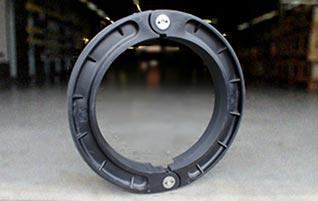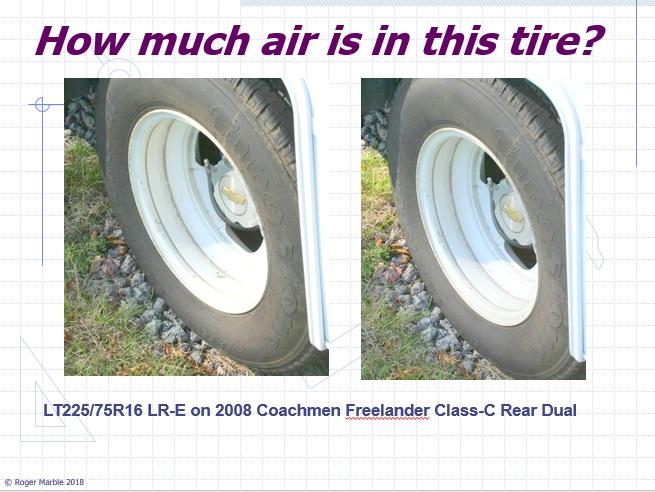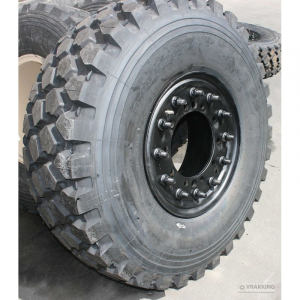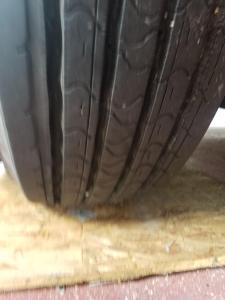-
Content Count
952 -
Joined
-
Last visited
-
Days Won
9
Posts posted by tireman9
-
-
On 12/11/2019 at 9:55 AM, kdherb said:Thank you all for your insight. I was browsing the forum and came across a post with a link to Tireman's blog and we are going to go with his ingenious plan. We bought 2 of the same Michelins (thru the FMCA Michelin program), will put those on the front today, move the 2 fronts to the back and then next year buy 2 more for the front, and then in 2021 buy 2 more. That way our newest tires will always be the front steer tires. We are doing this because the michelin dealer agreed that the tires are still in good shape (except for the blown one - maybe a defective tire?) and all of our tires are the same size. Thanks again to all those who responded. Happy holidays.
Actual "Defects" i.e. manufacturing mistakes usually occur relatively early in life. One recall I initiated was based on multiple tires failing in the first hundred miles as I recall (in 2000). Any chance you have pictures of the failed tire? Info for all . It is sometimes possible to provide a possible reason for failure if we can get 3 - 5 pictures of the failure.
Close enough to capture no more than 1/2 the tire. Good lighting i.e full Sunlight. Some times we can rule some causes out and sometimes we can get down to a couple of possibles. You can post a general picture but you can always email me the high quqlity pictures so I can zoom in.
Not running a TPMS doesn't help but you know that now. Did you check air pressure the morning of the failure? If so how many miles did you travel after the inflation check? There is a distinct possibility that whenever you checked the pressure a leak was started and being an inner dual there was almost no chance of you noticing the loss with the outer tire supporting the load.
Can you identify how much air in in the dual in the right shot? The left shot of the same tire in the picture below? This is a slide from my FMCA tire seminar.
-
First off I would not be concerned about a 20 psi (or 20%) increase in your 22.5 tires. Bet they are LR-G or LR-H
2nd yes air from a compressor can introduce some moisture that you will not get from the gas out of a cylinder. It isn't the N2 that is dry as all gas purchased from a "Air Supply" or welding shop in cylinders are going to be almost 0% moisture.
While I haven't seen and test data, the N2 from local Nitrogen generators may have some low %moisture as they probably use better dryers than found at most tire shops.
3rd If you are running new tires they will run a bit hotter than older worn tires. The 2% pressure for each 10F is close enough. Details and math can be seen HERE
You can always make and use your own "dryer" as seen HERE and if you support your tire with a jack you could let 50% out and re-inflate when you are in a dry weather day and dry location.
Just be sure your dryer is rated for the pressure you will be using. Be sure you have access to a good supply of high pressure air before you bleed off any air.
A quick check to see if this is even worth the effort would be to bleed off 5 psi and see if water drops or "fog" comes out of the tires. If not you don't have a lot of moisture in the tire to start with.
-
On 9/30/2019 at 6:09 PM, RayIN said:Michelin for instance, will void the warranty if certain things are purposefully put inside their tires. The Tyreon band comes to mind.
I'm not sure that something like Tyeron or Rettroband would have a negative impact on the ability of a tire to be repaired. It is this ability that is the driver behind the prohibition of the use of "Stuff" inside a tire. The bands would only come in contact with the tire if there had been a loss of air, probably due to a cut or un-repaired puncture.
-
Another item on matching Duals. The pair should always be same size, Load Range, Brand and design. Minimum Dual spacing is published in the tire company data sheets to help you compare.
You can read-up on Duals and their special needs on my RV Tire blog
-
Some tire companies "start the warranty clock" on the date the tires are made, others on the date the ties are mounted. Some when the RV is first sold.
My Class-C RV has a 2015 Chevy chassis but the RV is classified as a 2016. I did receive a "Delayed Warranty" document that started the GM Warranty in 2016 when I made the purchse.
-
I would stick with what is printed in the tire company literature for an approved rim for that companies tires.rather than a phone call.
-
On 10/13/2019 at 5:49 PM, desertdeals69 said:They might be for two different purposes. I would think if you reduce the volume of air by what looks to be half, it would produce a harder ride because of less volume of air that compresses.
Sorry but the tire changes shape when loaded and the air pressure basically doesn't change, while measurable with sufficiently sensitive gauges (laboratory 0.01 psi reading) I would not consider anything less than a 1 psi change meaningful even if you could measure it.
-
Basically you will find that for identical size, Load range and wheel rim width all brande are identical except for maybe a handful of Michelin tires being different by about 5 psi. This resulted from a tire that was already in production in Europe (designed completely Metric) then later made available in the US. The Metric to SI units conversion needed rounding which resulted is some tires being different a few psi
I have a list of links to tire Load & Inflation tables on my blog that I try and keep up to date.
-
20 hours ago, desertdeals69 said:I used to use them, not always smooth. Had better luck with balance beads.
As I understand how Centermatic system works you must be at some speed (more than 10 to 20 mph ?) for the rings to come into balance.
-
On 10/14/2019 at 9:42 AM, Mypopslou said:Tireman, I do not have a 4 corner weight but I do have axle weight, front axle is 13,820 and rear axle is 23491 GVWR is 38,600. Cold pressure is at 105, although as they heat up my TPMS reads 122
Thanks for your help
With a weight 13,820# I suggest you assume a 47/53% load split as a perfect 50/50 is very unlikely So 53% gives 7,325# which gives 115 psi according to the tables. ( You always go up in inflation)
I also suggest a +10% on inflation but not exceed tire sidewall number so that means 120 psi cold.
You will not find a "4 corner" scale except at FMCA Int'l conventions and some other large RV events. You can also contact RVSEF to check their schedule. You can also check with local sand & gravel companies, Concrete companies and some building supply companies. Here is the work sheet you will need to calculate your own 4 corner weights
-
Need to jump in here.
Starting in 1972 I worked on a number of different "Advance Tire" projects Some were looking at an "aftermarket" device that could be placed inside a tire to offer some "Run-Flat" capability. Foam Aluminum and foam Urithane were used. These worked but were too heavy and expensive for general use by the trucking industry and they were not willing to pay the penalty of the original cost and the loss of load capacity for the truck. Visually they would resemble the Rettroband. Here is a picture of a similar device. Having watched the Rettroband video it appears they have a unique method of "attaching" the ring which was one of the areas we did not finalize.

I was also the project leader on the original "Run-flat" tires applied to the people mover train at the then-new DFW airport. This approach involved filling the air chamber with a rubber foam material (not urethane but flexible rubber) I believe that this is the approach used on some military vehicles today.
This is not some secret "magic" stuff that is being kept from public use by the military as some have suggested and it is not some "Area 51" SiFi material. Just rubber with a blowing agent. If you were willing to spend maybe $500 - $1,000 a tire, limit speed to an average speed of 25 - 30 mph and do a complete redesign of your front suspension to handle the 150 to 200-pound increase in tire assy weight, I believe you can have this on your vehicle. Oh, you also would need to be willing to scrap the wheels when your tire wears out and you can not dismount a foam-filled tire. Other "run-flat" military systems use a flat base multi-piece wheel with an internal ring along the lines seen here.

Note how the flat base multipiece wheels are assembled.
Other approaches involved going from 22.5 wheels to 26.5 diameter wheel while retaining the same OD, width and load capacity as the original 11-22.5. We even had about 600 special wheels manufactured and we applied these wheels and tires to hundreds of HD trucks. I posted info on my tire blog about these tires. The problem with these tires is they needed new wheels. While these tires provided significant improvements in vehicle control with a sudden loss of air on the front. the trucking industry did not feel the improved safety outweighed the increased cost of new wheels.
The Tyron system does not appear to offer any support of the tire tread or feature to limit the "drop" which IMO is an important feature of limiting the degradation or loss of vehicle control due to "blowout" but is intended as I understand it to prevent the flat tire from being dislodged from the wheel.
Regarding the questions of lost air volume. No observable change in vehicle ride was noted with the change from 22.5 to 26.5 wheel diameter due to the lower air volume. If you are wondering about the effect of load on air volume you can do a simple test yourself. Inflate a large tire to a specific level and with the tire off the ground with floor jacks record the inflation with your TPMS. Then lower the floor jack and record the inflation when loaded. You can then post the results of your test on this thread for us all to see,
-
On 10/13/2019 at 1:49 PM, manholt said:It's my understanding that Tyron is now a standard in new Prevosts and Newell...I wonder why not Rettroband?
Probably the extra cost which is how the RV industry works IMO.
-
On 10/6/2019 at 8:18 PM, jleamont said:From an engineering perspective do you see where filling that large cavity inside the tire could cause issues with tire longevity?
Any idea how close to a fully inflated tire it resides, how far away would be considered “safe”?
Also do you think mounting the tire could be a concern, cause potential tire damage during the mounting process?
Based on the work I did on placing devices inside tires I am not aware of any problems as long as the normal operation deflection does not result in the interior of the tire contacting the device. While I do not have the data it appears that the clearance is in the- 3" range. Normal tire deflection when a tire is properly inflated for the load is in the 1" - 2" range.
I did watch a video on a tire being mounted and while there are some steps that need to be followed I don't see why damage would occur if the instructions were followed.
-
I don't see where the actual fully loaded "4 corner" weight.
Some input from a Michelin contact I have is suggesting the possibility if incorrect inflation for the actual load.
Could you post your 4 corner weights and your cold inflation numbers.
-
I am running a direct comparison of two different TPM systems (Tire Traker & TST) Early results have been posted on my blog. I am not aware of any other direct real-life comparison. (If anyone knows of such I would appreciate hearing about it.
I also, in my working life as a tire engineer, started working with TPMS in 2002
In general, it appears that most systems being offered today (in FMCA magazine and at FMCA Conventions) are similar in design and function.
I might suggest that you consider the warranty and the information provided on the company website and if they have a phone number.
-
I purchased Tire Tracker for my first RV back in 2009. I like the long battery life (days) of the monitor, user-replaceable batteries and the Lifetime Warranty of their current system. Also the ease of programming and the "early Warning" pressure levels.
Lower cost is nice too.
-
8 hours ago, WILDEBILL308 said:It doesn't matter what it "looks like", does it have the arrows cast into the sidewall near the tread.
Bill
Having a US Patent on directional tread design, in my professional opinion if it was "directional;" it would certainly "look" directional. Another item is that at 22,000 miles if there was some directionality to the pattern initially it appears to have been worn off.
I also note that Michelin does not list Directional design as either a feature or benefit so very unlikely.
-
On 9/28/2019 at 8:56 AM, manholt said:I had the Tyron installed on my AC 45, they came loose and destroyed my steer tires from the inside...$2,400 for set of 2, made in UK for military vehicles! This looks like the same thing, just from Australia & not UK. They are both made from an Armor company...I made a call to UK, spoke to the Warranty Dept., nope sorry, it's made for the military not camping wagon (their name for motorhomes). Buyer beware & get all the fine print, before you buy!
I saw the Rettroband at Minot. Not the same as Tyron.
Tyron "fills" the well of the wheel to try and prevent the tire from coming off the wheel. Appears to be smaller in OD than the wheel.
Rettroband is larger OD than the wheel and decreases the amount the tire "drops" and appears to allow better control after the tire loses air.
Back in the '70's I worked a bit on something like Rettro in concept but slightly different design and mounting.
I have not personally tested the Tyron or Rettroband so above is based on observations only.
-
54 minutes ago, WILDEBILL308 said:What are you talking about? This is the drivers side front steer tire not one of the duells.
Bill
The driver front has one side of the tire toward the center line of the RV and the other side of the tire is facing the road. If you change the direction of rotation of that tire by dismounting the tire from the wheel then re=mounting it on the wheel that will change the direction of rotation as Brett mentioned.
-
On 10/1/2019 at 11:41 AM, Mypopslou said:Recently returned from a 6700 trip this past summer. Noticed some odd tire wear on the drivers side front tire. See pictures attached.
Tires are Michelin XZA2 295/80R-22.5
Have 22,000 miles on them, keep them inflated to 105 lbs cold based on Michelin Tire/Weight Chart, added 10lbs fudge factor.
TPMS shows the pressure increase to max 122 lbs when they heat up, max heat has been 110 degrees, when in traffic, lowers as I get back to cruise speed.
Does it look like a may have an alignment issue or a defective tire (separation issue). Curb side front tire is showing a little outside wear but nothing like the left.
It looks like it is wearing another outside groove in the tread.
Planning on a trip to Cummins for an alignment check and tire rotation which I am hoping is the issue
Take a look at the pictures and let me know if you think there is another issue that would cause this.
Thanks for your help
4If uniform 360° around I would say not a belt separation but the tire design is sensitive to alignment.
I am checking with a contact at Michelin.
RE rotation. After alignment is checked and adjusted you could swap by changing tire inside to outside assuming the wear is only on one side to the one tire.
Sorry for slow reply was in NY Letchworth St Pk last week not poor cell reception No reception, no bars on two different phones.
-
On 9/23/2019 at 9:04 PM, manholt said:Patch? Sealants? OK, I'm Lost...
 What's that got to do with balance and bean bags?
What's that got to do with balance and bean bags?
In general tire companies do not want any "stuff" on the inside of tires as some "Balance Beads, sand or powder" as some call it, may abrade the interior. It is also important that you change the tire valve as the material placed in the tire can clog the valve core or even disable a TPM sensor. The "bean bags" break-up and the lose "beans" spread out inside the tire.
I expanded my post about "stuff" on the inside of tires as some materials are in liquid form and that would be sealants and possibly even some balance "stuff". These materials can coat the interior of a tire and make applying a tire patch (nail hole repair) difficult or impossible to reliably stick to the tire so if you put some materials on the inside of a tire and later on pick up a nail and need a patch you may be disappointed to be told the tire store is not willing to attempt a tire repair.
-
Before you use anything on the inside of your tires, be sure you confirm that it doesn't void your warranty. Sealants can make a tire un-repairable as the sealant material can prevent proper adhesion of the patch to the inside of the tire.
-
On 9/18/2019 at 11:17 AM, wayne77590 said:As you go higher or lower in altitude the pressure will increase or decrease 0.48 psi and the PSI will Increase/decrease 2.0 psi for every 10 degrees of temperature change.
Let's assume your max tire pressure is 110 psi and your minimum load weight pressure is 90 psi. A fudge factor of 10 psi would make the minimum load weight 100 psi. If you go from sea level to 10,000 feet altitude you would raise 4.8 psi and with the 90 to 40 degree change in temperature you would drop 10 psi for an overall psi change of 5.2 psi.
With the fudge factor of 10 psi you would still be within your minimum required load pressure. You can do the math for the inverse situation. I always set my tire pressure between the max the tire allows and the minimum required for the load. If you do not have the four corner weights then run max tire pressure allowed and be safe, only adjusting as needed when you get to your destination. There are other scenarios, I'll bet, and the closer the minimum and maximum tire pressures are, the less of a fudge factor is available.
Tireman9, Roger, please correct me if this is not correct and I'll ask for the post to be removed.
Sounds good to me.
-
On 9/9/2019 at 1:55 PM, kimenker said:I'm looking at all my options for new tires on my 2009 Winnebago Journey 37H I've purchased this last year with 2013 255/80-22.5 Michelin XRV tires on it now. I drove these tire not know to check age when purchased from NC to Vegas this last January. I'm looking at the (3) types of tires sold thru FMCA , Michelin, Hankook and Continental. However both Hankook and Continental only come close to the size I have now in 275/80-22.5. My question is will that size work on my coach?
One thing we need to know is the actual load on your tires. Load capacity is IMO more important than just tire age. Before you decide what tires to buy you need to load the RV to the heaviest you ever expect to be (Fuel, water, food clothes tools books i.e. everything. Then get "4 corner" weights. HERE is a worksheet that can help you with the math.
After you learn the weight on the heavy end of each axle feel free to contact me directly or post the numbers here. We can then work through the options. You might also check out my RV Tire Safety blog for general info on the "care and feeding" of your tires.







Comparing Coach Net, Good Sam & FMCA Roadside Assistance Coverage
in Roadside Assistance
Posted · Report reply
Does anyone have experience needing RA with a Class-C? Since I am not much smaller than a large Dually pick-up I would think I should be towed if the repair on the road was not possible.
As my chassis is a Chevy 4500 all the running gear should be serviceable at any GM dealership. I am pretty mechanically inclined but don't travel with my big main tool-chest so I may need a mechanic at some point in the future.